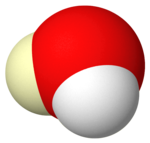Semiheavy water
| |||
| Names | |||
|---|---|---|---|
| IUPAC name
(O-2H1)Water
| |||
| Other names
Deuterium hydrogen monoxide
Deuterium hydrogen oxide, Water-d1, Water-d | |||
| Identifiers | |||
3D model (JSmol)
|
|||
| ChEBI | |||
| ChemSpider | |||
| 115 | |||
PubChem CID
|
|||
CompTox Dashboard (EPA)
|
|||
| |||
| |||
| Properties | |||
| H2HO or HDO | |||
| Molar mass | 19.0214 g mol−1 | ||
| Appearance | Very pale blue, transparent liquid, very similar to regular water | ||
| Density | 1.054 g cm−3 | ||
| Melting point | 3.81 °C (38.86 °F; 276.96 K) | ||
| Boiling point | 100.74 °C (213.33 °F; 373.89 K) | ||
| miscible | |||
| log P | −0.65 | ||
Except where otherwise noted, data are given for materials in their standard state (at 25 °C [77 °F], 100 kPa).
| |||
Semiheavy water is the result of replacing one of the protium (normal hydrogen, 1H) in normal water with deuterium (2H; or less correctly[1], D).[2] It exists whenever there is water with 1H and 2H in the mix. This is because hydrogen atoms (1,2H) are rapidly exchanged between water molecules. Water with 50% 1H and 50% 2H, is about 50% H2HO and 25% each of H2O and 2H2O, in dynamic equilibrium.[3] In normal water, about 1 molecule in 3,200 is HDO (1H2HO) (one hydrogen in 6,400 is 2H). By comparison, heavy water D2O or 2H2O[4] occurs at a proportion of about 1 molecule in 41 million (i.e., 1 in 6,4002). This makes semiheavy water far more common than "normal" heavy water.
The freezing point of semiheavy water is close to the freezing point of heavy water at 3.8°C compared to the 3.82°C of heavy water.
Production
[edit]On Earth, semiheavy water occurs naturally in normal water at a proportion of about 1 molecule in 3,200; because 1 in 6,400 hydrogen atoms in water is deuterium, which is 1 part in 3,200 by weight. HDO may be separated from normal water by distillation or electrolysis, or by various chemical exchange processes, all of which exploit a kinetic isotope effect. Partial enrichment also occurs in natural bodies of water under certain evaporation conditions.[5] (For more information about the distribution of deuterium in water, see Vienna Standard Mean Ocean Water and Hydrogen isotope biogeochemistry.)
See also
[edit]References
[edit]- ^ "Provisional Recommendations". Nomenclature of Inorganic Chemistry. Chemical Nomenclature and Structure Representation Division. IUPAC. § IR-3.3.2. Archived from the original on 27 October 2006. Retrieved 2024-12-30.
- ^ Tashakor S (2016-09-28). "Neutronic Investigation of Semi-Heavy Water Application in Hplwr New Flow Pattern". CNL Nuclear Review: 1–5. doi:10.12943/CNR.2016.00019.
- ^ Goncharuk VV, Kavitskaya AA, Romanyukina IY, Loboda OA (June 2013). "Revealing water's secrets: deuterium depleted water". Chemistry Central Journal. 7 (1): 103. doi:10.1186/1752-153X-7-103. PMC 3703265. PMID 23773696.
- ^ "Heavy water | chemical compound". Encyclopedia Britannica. Retrieved 2019-04-24.
- ^ Craig, H.; Gordon, L. I.; Horibe, Y. (1963). "Isotopic exchange effects in the evaporation of water: 1. Low-temperature experimental results". Journal of Geophysical Research. 68 (17): 5079–5087. Bibcode:1963JGR....68.5079C. doi:10.1029/JZ068i017p05079.
Further reading
[edit]- Schwarzer D, Lindner J, Vöhringer P (October 2005). "Energy relaxation versus spectral diffusion of the OH-stretching vibration of HOD in liquid-to-supercritical deuterated water". The Journal of Chemical Physics. 123 (16): 161105. Bibcode:2005JChPh.123p1105S. doi:10.1063/1.2110087. hdl:11858/00-001M-0000-0012-E7B7-2. PMID 16268674.



